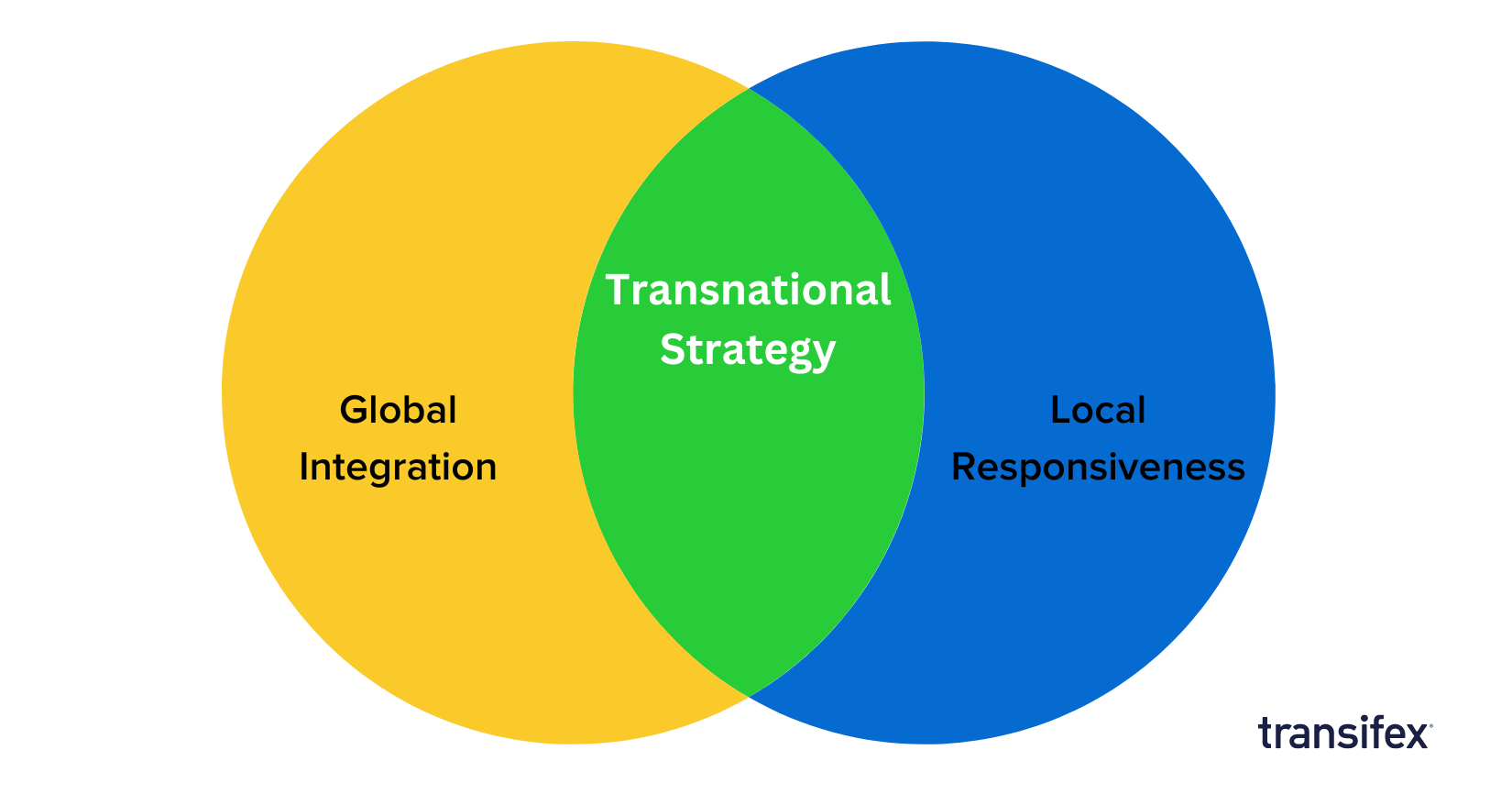A well-planned transnational strategy is an essential part of any business that aims to run and expand operations locally and globally at the same time.
But what exactly is a transnational strategy? How does it work, and how can you leverage it to boost your business’s global presence?
In this article, we share everything you need to know about transnational strategies if you’re looking to grow your business internationally.
Let’s dive in!
What is a transnational strategy?
Transnational strategy is one of the four main global expansion strategies that help businesses expand their operations internationally and reach global goals. A transnational business operates locally and globally, combining global integration with local responsiveness. That means a well-executed transnational strategy allows businesses to adapt to local preferences while expanding globally.
With a presence in different countries, a transnational business works to strengthen its global and local footprint, taking the right steps towards localization. This type of business knows that every country and culture responds differently to every company, so it customizes its products and services based on each location, with the aim of balancing local preferences with business goals and low costs.
One of the key elements of a successful transnational strategy is for the business to have in-depth knowledge of each market’s preferences, allowing it to adapt to their needs and make the appropriate differentiations for successful customization. This means it might need to remove aspects that don’t match a specific culture and add others that do.
For example, a restaurant that integrates a transnational strategy might have to remove from its menu certain dishes that don’t match the taste of customers in a specific country and add others that align with the country’s food culture.
What are the global expansion strategies?
Besides transnational strategy, three other global expansion strategies help businesses reach their international goals and thrive on a global level. The main areas these strategies focus on are customization, responsiveness, and global integration.
However, businesses can’t target these areas simultaneously, meaning every type of global expansion strategy focuses more on some aspects and less on others.
So, what are the different global expansion strategies, and what are their characteristics?
#1 Multi-domestic Strategy
A multi-domestic strategy uses a different marketing approach for every country it operates in rather than having a global strategy. It adjusts sales tactics, products, and services to match the customers’ preferences in every region, often including actions such as localization of the company’s website.
#2 International Strategy
An international strategy is one of the most common strategies for global expansion. Unlike other types of strategy, an international strategy doesn’t focus on local responsiveness, meaning it doesn’t make changes to adjust to each market. It aims to export and import products, keeping its head offices in the home country, focusing on the domestic market profits rather than foreign.
#3 Global Strategy
Companies that follow a global strategy operate in several countries and have a cost-effective approach regarding global services and product distribution. In this strategy type, businesses don’t have a locally responsive approach but offer the same or similar products in every country they operate in, focusing on global integration.
The pros of a transnational business strategy
A transnational strategy comes with many benefits for businesses that implement it properly. Those benefits include:
- Combining cost-efficiency with responsiveness
- Customization for every market
- Alignment with local culture and the needs and preferences of local markets and local customers
- Local competitiveness
- Optimized local market penetration
- Expansion in new international markets
- Brand awareness in local markets
- Competitive advantage against competitors that aren’t involved locally
- Lower costs thanks to local offices and reduced shipping costs
The cons of a transnational strategy
Although effective in many areas of business operations, a transnational strategy may have some disadvantages:
- It may reduce companies’ strategic autonomy
- It could alienate local customers, which may lead to increased costs
- It can be difficult for the business to manage offices and employees in all its locations
Examples of companies implementing a transnational strategy
Numerous companies worldwide implement a transnational strategy to achieve global integration and local responsiveness with their on-point geo-targeting campaign, including:
#1 Google
Although its headquarters are in California, USA, Google has several offices in other countries to serve local markets, leveraging the benefits of transnational strategy. Understanding the culture, history, and preferences of every country it operates in, Google offers customized services that increase user satisfaction and optimize interaction.
#2 Walmart
Walmart manages to keep prices low in every country it operates in but has customized the products and services it offers to match every market’s needs and preferences. Analyzing each market and adapting to local market conditions, this company leverages each country’s infrastructure and expertise to achieve local responsiveness and global expansion.
#3 KFC
KFC is another example of a transnational company, as it has restaurants in every part of the world, providing a high level of local responsiveness and valuing customers’ preferences in local markets. More specifically, it customizes the dishes offered in every country based on cultural criteria, having a different menu for each country.
#4 Unilever
Unilever is one of the most well-known transnational companies, managing to combine local responsiveness with global integration successfully. Localizing production and managing operations based on the needs of every country, Unilever offers high-quality products and achieves brand engagement across the globe.
How to execute a transnational strategy
Do you want to succeed globally, focus on local markets, global integration, and expansion in international markets, and achieve local responsiveness? Then, a well-executed transnational strategy is key. Numerous global companies follow this approach, yet not everyone succeeds.
A combination of the following aspects makes a transnational strategy successful:
- marketing efforts
- market research
- adhering to local cultural norms
- meeting local demands in overseas markets
What’s more, personalized content for every country is another element of a successful transnational strategy when it comes to a company’s website localization.
Lifting language barriers and offering users a personalized, friction-free online experience makes an online business stand out from competitors, increasing trust, customer engagement, satisfaction, and finally conversions. Transifex AI, an AI-powered end-to-end localization tool, enables you to generate localized SEO-friendly content that always aligns with your brand with just a click of a button.
With the speed and accuracy of AI, you can globalize your website, app, or promotional material and expand your business beyond borders!
Tips for creating a successful transnational strategy
Now that you know everything about transnational strategy, you might want to implement it in your business!
So, here are some tips for creating a transnational strategy that is customized to the local culture of every country, helping your business expand globally while achieving customer engagement:
- Conduct market research to help you understand the potential customers’ characteristics, needs, and preferences.
- Create a business model that can be easily modified to meet the needs of different markets.
- Align your global vision with your company’s values, goals, and aspirations.
- Make cross-border collaboration a central part of your strategy.
- Share knowledge and invest in optimizing learning processes.
- Monitor the results of your transnational strategy and make adjustments as needed.
- Be informed about global trends and continuously improve your strategy to stay up-to-date with them.
A well-executed transnational strategy is one of the best ways for a business to expand globally while achieving local responsiveness, offering customized products and services in every country. Using this strategy wisely, your business can thrive globally and grow in various markets. At Transifex, we help you grow quickly and effortlessly in new markets!
Ready to take your transnational strategy to the next level?
Transifex’s AI-powered localization hub helps you create and deliver consistent, culturally adapted content across any language and location.
Sign up for a free trial today and engage the world with the power of AI.











